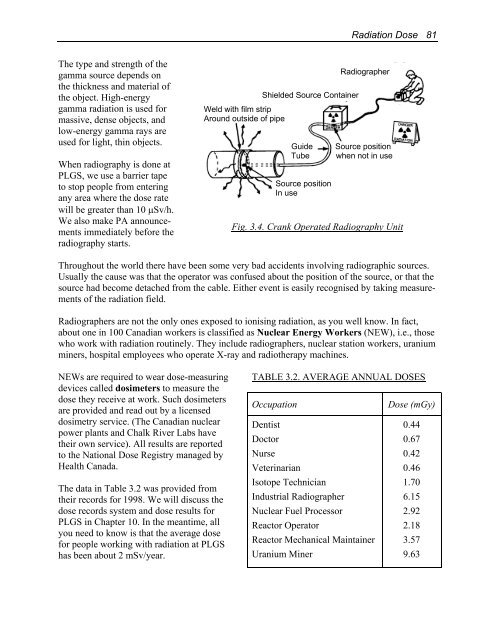CHAPTER 3 RADIATION DOSE
CHAPTER 3 RADIATION DOSE
CHAPTER 3 RADIATION DOSE
You also want an ePaper? Increase the reach of your titles
YUMPU automatically turns print PDFs into web optimized ePapers that Google loves.
Radiation Dose 81The type and strength of thegamma source depends onthe thickness and material ofthe object. High-energygamma radiation is used formassive, dense objects, andlow-energy gamma rays areused for light, thin objects.When radiography is done atPLGS, we use a barrier tapeto stop people from enteringany area where the dose ratewill be greater than 10 µSv/h.We also make PA announcementsimmediately before theradiography starts.Shielded Source ContainerWeld with film stripAround outside of pipeGuideTubeSource positionIn useRadiographerSource positionwhen not in useFig. 3.4. Crank Operated Radiography UnitThroughout the world there have been some very bad accidents involving radiographic sources.Usually the cause was that the operator was confused about the position of the source, or that thesource had become detached from the cable. Either event is easily recognised by taking measurementsof the radiation field.Radiographers are not the only ones exposed to ionising radiation, as you well know. In fact,about one in 100 Canadian workers is classified as Nuclear Energy Workers (NEW), i.e., thosewho work with radiation routinely. They include radiographers, nuclear station workers, uraniumminers, hospital employees who operate X-ray and radiotherapy machines.NEWs are required to wear dose-measuringdevices called dosimeters to measure thedose they receive at work. Such dosimetersare provided and read out by a licenseddosimetry service. (The Canadian nuclearpower plants and Chalk River Labs havetheir own service). All results are reportedto the National Dose Registry managed byHealth Canada.The data in Table 3.2 was provided fromtheir records for 1998. We will discuss thedose records system and dose results forPLGS in Chapter 10. In the meantime, allyou need to know is that the average dosefor people working with radiation at PLGShas been about 2 mSv/year.TABLE 3.2. AVERAGE ANNUAL <strong>DOSE</strong>SOccupationDose (mGy)Dentist0.44Doctor0.67Nurse0.42Veterinarian0.46Isotope Technician1.70Industrial Radiographer6.15Nuclear Fuel Processor2.92Reactor Operator2.18Reactor Mechanical Maintainer 3.57Uranium Miner9.63
















